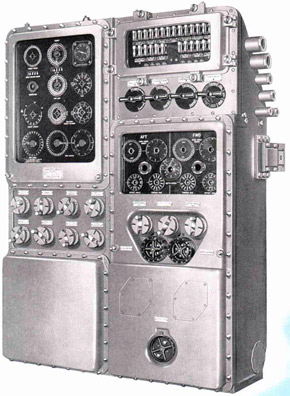TORPEDO COMPUTER
- Divided into lightweight and heavyweight classes
- Example : U.S Navy Mk III Torpedo Data Computer ( TDC) ;the standard U.S Navy Torpedo fire computer during World War II.
- In World War II (1943) TDC Mk III replaced by TDC MK IV, which improved and larger version of MK III
- TDC is early electromechanical analog computer used for torpedo fire-control on American submarines during World War II
- Britain, German and Japan also develop automated torpedo fire-control equipment, but none were as advanced as U.S Navy Torpedo Data Computer ( able to automatically track the target rather than simply offering instantaneous firing solution)
- It also can act as underwater self-propelled explosive which applied as primitive naval mines.

The TDC aboard Pampanito is a Mark III and one of only two of its type installed on a historic submarine, the other is aboard the USS Bowfin in Honolulu.Pampanito's TDC has been restored to fully operational.
The TDC was unique in World War II. It was the computational part of the first submerged integrated fire control system that could track a target and continuously aim torpedoes by setting their gyro angles. The TDC Mark III gave the U.S. fleet submarine the ability to fire torpedoes without first estimating a future firing position, changing the ship's course, or steering to that position. Instead of hoping that nothing in the setup changed, a fleet submarine with the TDC could fire at the target when the captain judged the probability of making hits to be optimal.
In World War II a torpedo's gyro angle was set mechanically while it was in the tube. A shaft, known as the spindle, slipped into a socket near the housing of the torpedo's course gyroscope. When the fire control system rotated the shaft, the gyroscope rotated. After being fired, the torpedo traveled on a straight course for a known distance called the reach. A delay in the release of the torpedo's gyro steering mechanism by a threaded shaft determined the magnitude of the reach. Once engaged, the steering mechanism brought the torpedo to a new course based on the angular offset of the gyroscope.
The Mark III computer consisted of two sections, the position keeper and the angle solver. The position keeper tracked the target and predicted its current position. To do this, the position keeper automatically received input of the ship's own course from the gyro compass, and own ship's speed from the pit log. The position keeper had hand cranks on its face that set the target length, estimated speed, and angle on the bow. It also contained a sound bearing converter that calculated the target's location based on sonar measurements.
The position keeper solved the equations of motion integrated over time. The result was a continuous prediction of where the target was at any instant. Successive measurements of the targets' position were compared to the position keeper predictions and corrections for error were introduced with the hand cranks. The predicted target position became more accurate as more measurements made the corrections smaller. It was typical to get an accurate track on the target after about three or four observations under good conditions.
The angle solver automatically took the target's predicted position from the position keeper, combined it with the tactical properties of the torpedo, and solved for the torpedo gyro angle. Values calculated from this solution were returned to the position keeper in two feedback loops. The gyro angle automatically went to each of the torpedo rooms and set into the torpedoes continuously. The TDC controlled both torpedo rooms and all 10 torpedo tubes at once.
The U.S. Navy thus had a system that would point the torpedoes at a target as the fire control problem developed. The TDC Mark III was the only torpedo targeting system of the time that both solved for the gyro angle and tracked the target in real time. The comparable systems used by both Germany and Japan could compute and set the gyro angle for a fixed time in the future, but did not track the target. Thus the idea of the position keeper, and its iterative reduction of target position error was unique to the U.S. Navy, and represented a distinct advantage.
source from http://maritime.org/tech/tdc.htm
No comments:
Post a Comment